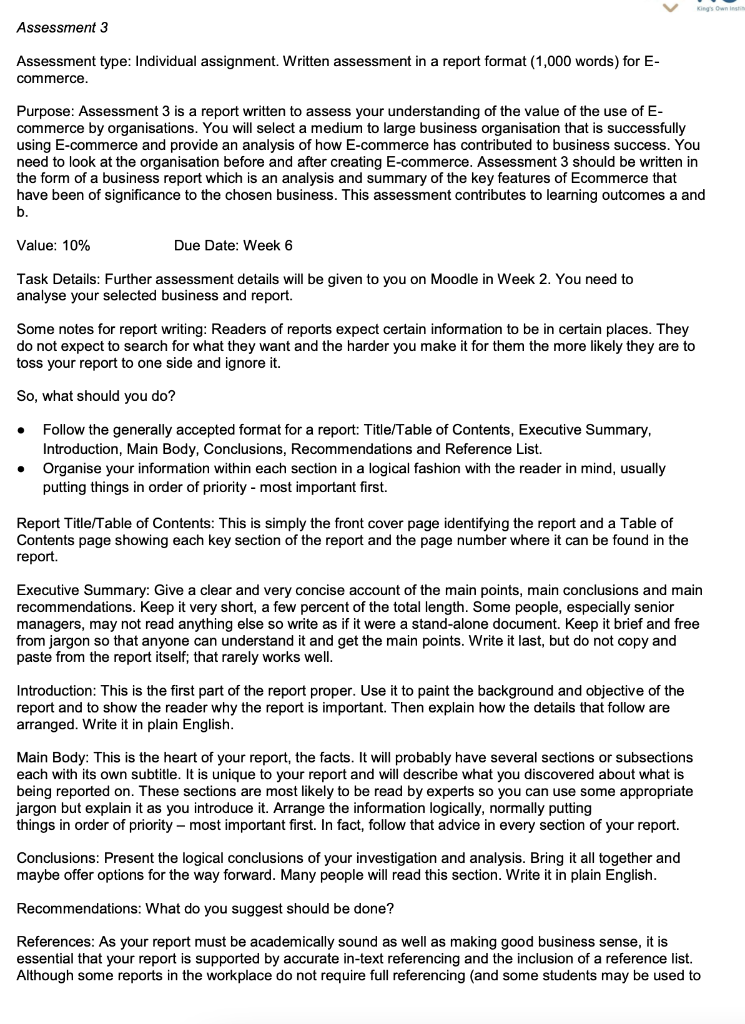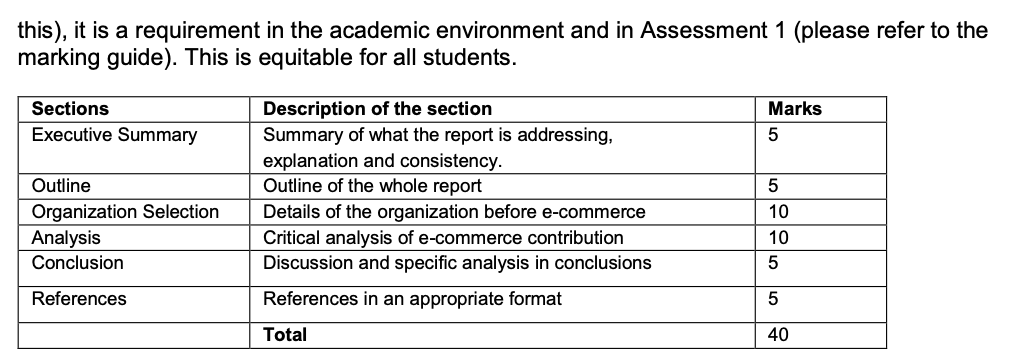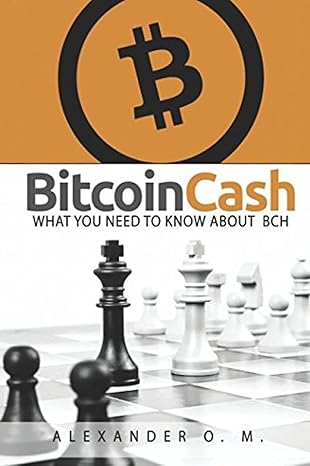Take CISCO as a company
Take CISCO as a company
Take CISCO as a company
Take CISCO as a company....
PLEASEEE PLEASEEE PLEASEEE


Kings Own Assessment 3 Assessment type: Individual assignment. Written assessment in a report format (1,000 words) for E- commerce. Purpose: Assessment 3 is a report written to assess your understanding of the value of the use of E- commerce by organisations. You will select a medium to large business organisation that is successfully using E-commerce and provide an analysis of how E-commerce has contributed to business success. You need to look at the organisation before and after creating E-commerce. Assessment 3 should be written in the form of a business report which is an analysis and summary of the key features of Ecommerce that have been of significance to the chosen business. This assessment contributes to learning outcomes a and b. Value: 10% Due Date: Week 6 Task Details: Further assessment details will be given to you on Moodle in Week 2. You need to analyse your selected business and report. Some notes for report writing: Readers of reports expect certain information to be in certain places. They do not expect to search for what they want and the harder you make it for them the more likely they are to toss your report to one side and ignore it. So, what should you do? Follow the generally accepted format for a report: Title/Table of Contents, Executive Summary, Introduction, Main Body, Conclusions, Recommendations and Reference List. Organise your information within each section in a logical fashion with the reader in mind, usually putting things in order of priority - most important first. Report Title/Table of Contents: This is simply the front cover page identifying the report and a Table of Contents page showing each key section of the report and the page number where it can be found in the report. Executive Summary: Give a clear and very concise account of the main points, main conclusions and main recommendations. Keep it very short, a few percent of the total length. Some people, especially senior managers, may not read anything else so write as if it were a stand-alone document. Keep it brief and free from jargon so that anyone can understand it and get the main points. Write it last, but do not copy and paste from the report itself; that rarely works well. Introduction: This is the first part of the report proper. Use it to paint the background and objective of the report and to show the reader why the report is important. Then explain how the details that follow are arranged. Write it in plain English. Main Body: This is the heart of your report, the facts. It will probably have several sections or subsections each with its own subtitle. It is unique to your report and will describe what you discovered about what is being reported on. These sections are most likely to be read by experts so you can use some appropriate jargon but explain it as you introduce it. Arrange the information logically, normally putting things in order of priority - most important first. In fact, follow that advice in every section of your report. Conclusions: Present the logical conclusions of your investigation and analysis. Bring it all together and maybe offer options for way Many people will read this section. Write it in plain English. Recommendations: What do you suggest should be done? References: As your report must be academically sound as well as making good business sense, it is essential that your report is supported by accurate in-text referencing and the inclusion of a reference list. Although some reports in the workplace do not require full referencing (and some students may be used to this), it is a requirement in the academic environment and in Assessment 1 (please refer to the marking guide). This is equitable for all students. Sections Executive Summary Marks 5 Outline Organization Selection Analysis Conclusion Description of the section Summary of what the report is addressing, explanation and consistency. Outline of the whole report Details of the organization before e-commerce Critical analysis of e-commerce contribution Discussion and specific analysis in conclusions References in an appropriate format 5 10 10 5 References 5 Total 40 Kings Own Assessment 3 Assessment type: Individual assignment. Written assessment in a report format (1,000 words) for E- commerce. Purpose: Assessment 3 is a report written to assess your understanding of the value of the use of E- commerce by organisations. You will select a medium to large business organisation that is successfully using E-commerce and provide an analysis of how E-commerce has contributed to business success. You need to look at the organisation before and after creating E-commerce. Assessment 3 should be written in the form of a business report which is an analysis and summary of the key features of Ecommerce that have been of significance to the chosen business. This assessment contributes to learning outcomes a and b. Value: 10% Due Date: Week 6 Task Details: Further assessment details will be given to you on Moodle in Week 2. You need to analyse your selected business and report. Some notes for report writing: Readers of reports expect certain information to be in certain places. They do not expect to search for what they want and the harder you make it for them the more likely they are to toss your report to one side and ignore it. So, what should you do? Follow the generally accepted format for a report: Title/Table of Contents, Executive Summary, Introduction, Main Body, Conclusions, Recommendations and Reference List. Organise your information within each section in a logical fashion with the reader in mind, usually putting things in order of priority - most important first. Report Title/Table of Contents: This is simply the front cover page identifying the report and a Table of Contents page showing each key section of the report and the page number where it can be found in the report. Executive Summary: Give a clear and very concise account of the main points, main conclusions and main recommendations. Keep it very short, a few percent of the total length. Some people, especially senior managers, may not read anything else so write as if it were a stand-alone document. Keep it brief and free from jargon so that anyone can understand it and get the main points. Write it last, but do not copy and paste from the report itself; that rarely works well. Introduction: This is the first part of the report proper. Use it to paint the background and objective of the report and to show the reader why the report is important. Then explain how the details that follow are arranged. Write it in plain English. Main Body: This is the heart of your report, the facts. It will probably have several sections or subsections each with its own subtitle. It is unique to your report and will describe what you discovered about what is being reported on. These sections are most likely to be read by experts so you can use some appropriate jargon but explain it as you introduce it. Arrange the information logically, normally putting things in order of priority - most important first. In fact, follow that advice in every section of your report. Conclusions: Present the logical conclusions of your investigation and analysis. Bring it all together and maybe offer options for way Many people will read this section. Write it in plain English. Recommendations: What do you suggest should be done? References: As your report must be academically sound as well as making good business sense, it is essential that your report is supported by accurate in-text referencing and the inclusion of a reference list. Although some reports in the workplace do not require full referencing (and some students may be used to this), it is a requirement in the academic environment and in Assessment 1 (please refer to the marking guide). This is equitable for all students. Sections Executive Summary Marks 5 Outline Organization Selection Analysis Conclusion Description of the section Summary of what the report is addressing, explanation and consistency. Outline of the whole report Details of the organization before e-commerce Critical analysis of e-commerce contribution Discussion and specific analysis in conclusions References in an appropriate format 5 10 10 5 References 5 Total 40








